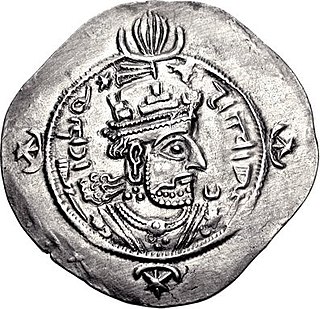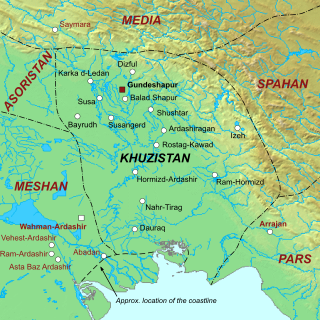
Shērōē, better known by his dynastic name of Kavad II, was king (shah) of the Sasanian Empire briefly in 628. He was the son of Khosrow II, whom he succeeded after having him overthrown in a coup d'état. Kavad's reign is seen as a turning point in Sasanian history, and has been argued by some scholars as playing a key role in the fall of the Sasanian Empire.

Bahram IV, was the Sasanian King of Kings of Iran from 388 to 399. He was the son and successor of Shapur III.

Bahram V, also known as Bahram Gor was the Sasanian King of Kings (shahanshah) from 420 to 438.

Sakastan was a Sasanian province in Late Antiquity, that lay within the kust of Nemroz. The province bordered Kirman in the west, Spahan in the north west, Kushanshahr in the north east, and Turan in the south east. The governor of the province held the title of marzban. The governor also held the title of "Sakanshah" until the title was abolished in ca. 459/60.

Mazun was a Sasanian province in Late Antiquity, which corresponded to modern day Bahrain, Qatar, United Arab Emirates, and the northern half of Oman. The province served as a Sasanian outpost, and played an important role in the Sasanian efforts to gain control over the Indian Ocean trade, and to establish their dominance in the wealthy regions of Hadramaut and Yemen.

The Sasanian or Sassanid Empire, officially known as the Empire of Iranians, and called the Neo-Persian Empire by historians, was the last Persian imperial dynasty before the Muslim conquest in the mid seventh century AD. Named after the House of Sasan, it endured for over four centuries, from 224 to 651 AD, making it the longest-lived Persian dynasty. The Sasanian Empire succeeded the Parthian Empire, and reestablished the Iranians as a superpower in late antiquity, alongside its neighbouring arch-rival, the Roman-Byzantine Empire.

Kushanshahr was a province of the Sasanian Empire comprising the region between Kabul Valley and Peshawar Valley. The Kushanshar territory centered on Tukharistan, and covered the area from Tirmidh to Peshawar. The establishment of Sasanian rule in Kushanshar permitted the control of Central Asian trade routes. The Kushano-Sasanids were in charge of the area. They issued coinage which was following the Kushan standard, due to the traditional importance of trade links with India.

Meshan was a province of the Sasanian Empire. It consisted of the Parthian vassal kingdoms of Mesene and Characene and reached north along the Shatt al-Arab river and then the lower Tigris to Madhar and possibly further. Its inhabitants included Babylonians, Arabs, Iranians, and even some Indians and Malays. The province was very fertile, the best place for barley according to Strabo, and contained many date palms. It was also an important trading province along the Persian Gulf.

Padishkhwārgar was a Sasanian province in Late Antiquity, which almost corresponded to the present-day provinces of Mazandaran and Gilan. The province bordered Adurbadagan and Balasagan in the west, Gurgan in the east, and Spahan in south. The main cities of the province were Amol and Rasht.
The Daylamites or Dailamites were an Iranian people inhabiting the Daylam—the mountainous regions of northern Iran on the southwest coast of the Caspian Sea, now comprising the southeastern half of Gilan Province.

The Church of the East, also called the Persian Church, or the Nestorian Church, was an Eastern Christian church of the East Syriac Rite, based in Mesopotamia. It was one of three major branches of Eastern Christianity, that arose from the Christological controversies of the 5th and 6th centuries, alongside the Oriental Orthodox Churches and the Eastern Orthodox Church. During the Early Modern period, a series of schisms gave rise to rival patriarchates, sometimes two, sometimes three. Since the latter half of the 20th century, three churches claim the heritage of the Church of the East.

Spahan, also known as Parthau was a Sasanian province in Late Antiquity, that lay within central Iran, almost corresponding to the present-day Isfahan Province in Iran.

Turan was a province of the Sasanian Empire located in present-day Pakistan. The province was mainly populated by Indians, and bordered Paradan in the west, Hind in the east, Sakastan in the north, and Makuran in the south. The main city and bastion of the province was Bauterna (Khuzdar/Quzdar). The province was originally a kingdom, before submitting to the first Sasanian monarch Ardashir I. It was governed by the Sakanshah, the first notable one being Ardashir I's grandson, Narseh. The province is mentioned in Shapur I's inscription at the Ka'ba-ye Zartosht.
Yazdin was an influential Iranian aristocrat, who served as the financial minister of the Sasanian king Khosrow II.

Veh-Ardashir, was an ancient Sasanian city in present-day Iraq, and formed a suburb of their capital, Ctesiphon.

Sasanian Egypt refers to the brief rule of Egypt and parts of Libya by the Sasanian Empire. It lasted from 618 to 628, until the Sasanian general Shahrbaraz made an alliance with the Roman Byzantine emperor Heraclius to have control over Egypt returned to him.

Harev, was a Sasanian province in Late Antiquity, that lay within the kust of Khorasan. The province bordered Kushanshahr in the west, Abarshahr in the east, Marv in the north, and Sakastan in the south.
Eran-asan-kerd-Kawad or Iran asan kar(t) Kavad was a Sasanian city founded by Kavad I in the Hulwan region. It was the capital of a province possibly identical to the Hulwan region and bordering the provinces of Syarazur (Shahrizor) and Garamig. The geographer Josef Markwart placed the city between Adiabene and Garamig. It is mentioned in both Armenian sources and the Middle Persian Šahrestānīhā ī Ērānšahr.

Khuzistan or Huzistan was a Sasanian province in Late Antiquity, which almost corresponded to the present-day province of Khuzestan. Its capital was Gundeshapur. During the late Sasanian era, the province was included in the southern quadrant (kust) of Nemroz.

Garmekan or Garamig was an early Sasanian province located in northern Mesopotamia, between the Little Zab and Diyala river. Its capital was Karka d-Beth Slokh. The province is omitted in Shapur I's list of provinces in the Ka'ba-ye Zartosht inscription, which indicates that it was part of Nodshiragan during that period. Garmekan is first attested as a Sasanian province in the Paikuli inscription of Narseh in 293/4, who describes how the aristocracy of Asoristan, Garmekan, and Shahrazur met him at Hayan i Nikatra in order to convince him to the become the new king. Before the Council of Seleucia-Ctesiphon in 410, Garmekan had been merged with the province of Nodshiragan, becoming known as Garamig ud Nodardashiragan.
















